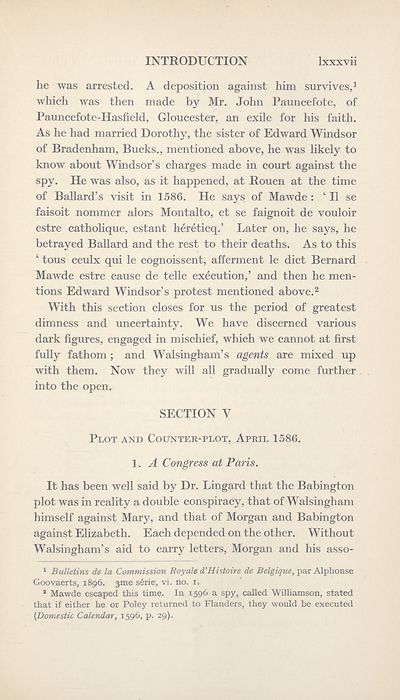Series 3 > Mary Queen of Scots and the Babington plot
(92) Page lxxxvii
Download files
Complete book:
Individual page:
Thumbnail gallery: Grid view | List view

INTRODUCTION
Ixxxvii
he was arrested. A deposition against him survives,1
which was then made by Mr. John Pauncefote, of
Pauncefote-Hasfield, Gloucester, an exile for his faith.
As he had married Dorothy, the sister of Edward Windsor
of Bradenham, Bucks., mentioned above, he was likely to
know about Windsor’s charges made in court against the
spy. He was also, as it happened, at Rouen at the time
of Ballard’s visit in 1586. He says of Mawde : ‘ II se
faisoit nommer alors Montalto, et se faignoit de vouloir
estre catholique, estant hereticq.’ Later on, he says, he
betrayed Ballard and the rest to their deaths. As to this
‘ tous ceulx qui le cognoissent, afferment le diet Bernard
Mawde estre cause de telle execution,’ and then he men¬
tions Edward Windsor’s protest mentioned above.2
With this section closes for us the period of greatest
dimness and uncertainty. We have discerned various
dark figures, engaged in mischief, which we cannot at first
fully fathom ; and Walsingham’s agents are mixed up
with them. Now they will all gradually come further
into the open.
SECTION V
Plot and Counter-plot, April 1586.
1. A Congress at Paris.
It has been well said by Dr. Lingard that the Babington
plot was in reality a double conspiracy, that of Walsingham
himself against Mary, and that of Morgan and Babington
against Elizabeth. Each depended on the other. Without
Walsingham’s aid to carry letters, Morgan and his asso-
1 Bulletins de la Commission Roy ale d’Histoire de Belgique, par Alphonse
Goovaerts, 1896. 3me serie, vi. no. 1.
2 Mawde escaped this time. In 1596 a spy, called Williamson, stated
that if either he or Poley returned to Flanders, they would be executed
{Domestic Calendar, 1596, p. 29).
Ixxxvii
he was arrested. A deposition against him survives,1
which was then made by Mr. John Pauncefote, of
Pauncefote-Hasfield, Gloucester, an exile for his faith.
As he had married Dorothy, the sister of Edward Windsor
of Bradenham, Bucks., mentioned above, he was likely to
know about Windsor’s charges made in court against the
spy. He was also, as it happened, at Rouen at the time
of Ballard’s visit in 1586. He says of Mawde : ‘ II se
faisoit nommer alors Montalto, et se faignoit de vouloir
estre catholique, estant hereticq.’ Later on, he says, he
betrayed Ballard and the rest to their deaths. As to this
‘ tous ceulx qui le cognoissent, afferment le diet Bernard
Mawde estre cause de telle execution,’ and then he men¬
tions Edward Windsor’s protest mentioned above.2
With this section closes for us the period of greatest
dimness and uncertainty. We have discerned various
dark figures, engaged in mischief, which we cannot at first
fully fathom ; and Walsingham’s agents are mixed up
with them. Now they will all gradually come further
into the open.
SECTION V
Plot and Counter-plot, April 1586.
1. A Congress at Paris.
It has been well said by Dr. Lingard that the Babington
plot was in reality a double conspiracy, that of Walsingham
himself against Mary, and that of Morgan and Babington
against Elizabeth. Each depended on the other. Without
Walsingham’s aid to carry letters, Morgan and his asso-
1 Bulletins de la Commission Roy ale d’Histoire de Belgique, par Alphonse
Goovaerts, 1896. 3me serie, vi. no. 1.
2 Mawde escaped this time. In 1596 a spy, called Williamson, stated
that if either he or Poley returned to Flanders, they would be executed
{Domestic Calendar, 1596, p. 29).
Set display mode to:
![]() Universal Viewer |
Universal Viewer | ![]() Mirador |
Large image | Transcription
Mirador |
Large image | Transcription
Images and transcriptions on this page, including medium image downloads, may be used under the Creative Commons Attribution 4.0 International Licence unless otherwise stated. ![]()
| Scottish History Society volumes > Series 3 > Mary Queen of Scots and the Babington plot > (92) Page lxxxvii |
|---|
| Permanent URL | https://digital.nls.uk/127235145 |
|---|
| Attribution and copyright: |
|
|---|
| Description | Over 180 volumes, published by the Scottish History Society, containing original sources on Scotland's history and people. With a wide range of subjects, the books collectively cover all periods from the 12th to 20th centuries, and reflect changing trends in Scottish history. Sources are accompanied by scholarly interpretation, references and bibliographies. Volumes are usually published annually, and more digitised volumes will be added as they become available. |
|---|


